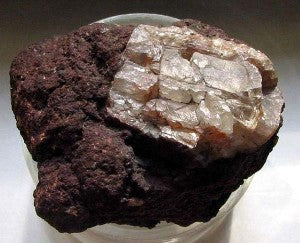
Anorthite is a natural mineral, calcium feldspar, which is a subgroup of plagioclase. Outwardly, the product of mountain igneous rocks may resemble scapolite, amblygonite, and feldspar with an alkaline structure, however, it differs from them in a sparkling gleam on the cleavage and angle value on the cohesive planes. The mineral is formed in igneous basalts, gabbros and diabases, and can be combined with amphiboles, pyroxenes, olivine and magnetite. The chemical composition of anorthite is calcium aluminosilicate with possible impurities of iron, strontium, barium, titanium, and potassium. A fragile mineral with a frosted glass luster and uneven shell-like fracture is opaque and transparent, muddy and translucent. It is exposed to acids, but it melts with difficulty. In nature, it occurs in the form of granular or solid masses, as well as prismatic crystals. During weathering, anorthite crystals lose their natural luster, the surface acquires a rough appearance with a white coating, which contains clay mixtures and hydromica.
Officially anortite, found in the area of Vesuvius, is described and recorded in 1823 by the mineralogist from Germany Gustav Rose. The name of the stone received from the Greek ("an" - not, "orthos" - straight) because of the peculiar oblique shape. Anortic collateral is called rosit, lynx eye and calcicylase.
Types and Colors of Anorthite:
The basic color palette of anorthite are white-gray shades. There are samples of red with yellow shades and a characteristic white line, as well as crystals with iridescence in green and blue tones. Depending on colors and shades, ornamental and jewelry samples of anorthite have the following names: lepolite is a gray stone with greenish hues; diploit - red crystals with yellow shades; black moonstone - translucent samples with the irides property. Anorthite is also classified according to the inclusion of chemical elements and their replacement: halist - an artificial stone in which aluminum is replaced by gallium; Calisty - a substitute for natural anorthite with a K2O content of more than 6.5%; gauin is a hypothetical substance containing calcium and belonging to the sodalite group; barium - anortite substitute with the content of BaO not more than 5.5%; Germanic is an artificial sample, in which silicon is replaced by germanium.
Anorthite Mineral Deposits:
Anorthite deposits in the composition of igneous rocks are found on every continent of the planet, but crystals of pure mineral are rare. In Eurasia, deposits are located in Russia, Ukraine, Austria, France, Germany, Greece, Italy, Hungary, Poland, Romania, Switzerland, Sweden, Slovakia, Great Britain, China, Japan, Kazakhstan, Kyrgyzstan, and India. In Africa, anortite is mined in Central African Republic, Angola, Algeria, the Republic of the Congo, Guinea, Cameroon and Tanzania.
The countries of South and North America — Argentina, Brazil, Bolivia, Peru, Paraguay, Mexico, Canada, and the USA — are famous for their anorthite deposits. There are deposits of rock in Australia, Antarctica, New Zealand and the waters of the Pacific Ocean.
Use of Anorthite:
The main industry in which anortite has found application is the jewelry industry. Amazing pendants, beads and cufflinks are made from cabochon-treated varieties of stone with an optical effect. Transparent crystals, which are found quite rarely, are processed along bright edges and are exhibited in collections. Anortite with zonal iridescence in silver-blue shades is used for the manufacture of handicrafts and inlays. Like all plagioclases, anortite is included in the concentrate that is used in the manufacture of ceramics.
